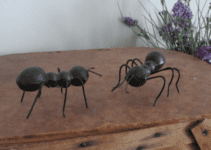First of all, raccoons sometimes referred to as “masked bandits”, are amazing to watch. They are very smart and human like with their use of their hands. However, they are wild animals and will behave like wild animals.

By Tiffany Carboni – See more Home Design Photos
Raccoons are usually classified as a pest species due to their habits of living in human dwellings.
This is due primarily to the fact that they are extremely adept at dumpster diving. Being omnivorous, they do not care what they eat. Everything is edible and you toss it in the garbage, they’ll eat it.
Many homeowners have problems with the damages caused by these creatures. Raccoons have bad habits: they vandalize garbage cans, fish ponds, and even your kitchen pantry – due to the fact that many homes (especially in the United States) have a pet door, which for a raccoon is like an invitation.
Besides this, the most common complaints may include the following:
a) Raccoons living in the attic; they like to make dens in attics
b) Raccoons living in the chimney; they like to make dens in chimneys
c) Tipping over garbage cans
d) Stealing pet food or bird seed
e) Sick, potentially rabid raccoon; Rabies is transmitted through saliva from the infected raccoon to humans and pets, often through a bite
f) Presence is alarming dogs/pets
g) Raccoons chew through electrical wires to clear access to a den site; frayed wires pose a serious fire hazard, especially if close to flammable materials like wood or insulation
h) They are nocturnal (i.e. active at night), making them quite a nuisance when homeowners are trying to sleep
i) Raccoon feces are commonly infected with a roundworm known as Baylisascaris. If the eggs are ingested by humans, they can cause nausea, organ malfunction, blindness, loss of muscle control and even death
Control Wasps, Hornets and Yellowjackets – Tips and Ideas (howtobuildahouseblog.com)
How to Get Rid of Raccoons:
The primary approaches are trapping, prevention, and repellents.
1 – Trapping: Trapping is always an option for wildlife removal. However, it’s not always so cut and dry. Much of the time, simple trapping does not solve the problem. In fact, traps are not even worthwhile investing in.
a) First of all, it’s probably illegal for you to trap and remove and relocate raccoons on your own in the state you live. In many states, because the raccoon is a rabies vector, it’s often illegal to relocate them.
b) Secondly, if you catch a raccoon in a trap and take it 10 miles away, another raccoon family is ready to move in. There are from 20 to 50 raccoon families per square mile in urban areas.
c) The majority of cases of do-it-yourself raccoon trapping have gone awry. It’s common to catch the wrong animal – a stray cat, a skunk, or opossum, or the wrong raccoon.
d) DO NOT TRY TO TRAP and remove if you have raccoons in the attic. Nine times out of ten, there are baby raccoons up there.
2 – Prevention & Repellents:
1/ The sound of a human voice is known to drive away raccoons. Place a radio, set to a talk radio station, in the vicinity of their nest. It doesn’t have to be loud, start with a low volume level. If it doesn’t get results, try increasing the volume. Leave the radio on day and night.
2/ Remove potential food sources for the raccoons, especially trash cans or outdoor food bowls for pets and bird feeders. If possible, empty pet food bowls at dusk. Also, if possible, store garbage cans inside the garage.
3/ If a raccoon is continually getting into your trash, try a few of these tips to discourage them. Purchase trash cans that have lids that lock into place and use a bungee cord to help hold down the lid. You can also place a heavy object on the lid.
4/ Raccoons prefer dark places for their nests. If you can light up your attic or crawlspace, this will disturb the raccoons, possibly enough to make them move out.
5/ Raccoons are clean animals; in fact they often wash their food before eating. Because of this habit of cleanliness, they do not foul their nests. Sprinkle 1 cup of ammonia around the inside of each trash can. Sprinkle several cups of ammonia sulfate on the ground in the area you believe raccoons are visiting, such as on the ground where the trash cans sit. If you have difficulty reaching the den, you might be able to apply ammonia in the vicinity with a squirt bottle. Ammonia, a chemical found in urine, is an offensive odor for raccoons.
6/ A wise thing to do if you have problems with raccoons in attic is to simply wait; in other words, many of the problems made by raccoons (for example: occupation of a building) resolve themselves within a few weeks or – if you are lucky – in a few days. If cubs are also causing you problems, you should know that they won’t leave your attic until they are nine weeks of age, because until then, they can’t take care of themselves
Keeping the Raccoons Out after They Have Gone:
Once the raccoons are out, you must seal their access to your home. If you aren’t certain if they are out, seal all but one exit.
Adult raccoons can fit through and opening about 3 or 4 inches in diameter. Inspect under your eaves, especially where valleys occur. Raccoons are strong and have dexterous fingers.
Repair holes and openings with heavy wire cloth, steel flashing or solid wood. You should secure with several screws or nails to a solid substrate.


